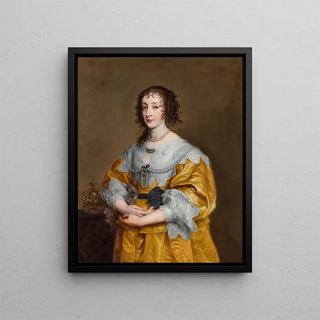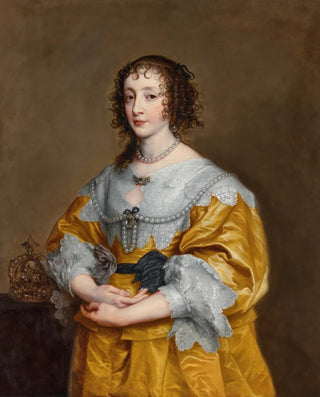Art print | Portrait of Queen Henriette Marie - Antoine van Dyck


View from behind

Frame (optional)
Portrait of Queen Henriette Marie - Antoine van Dyck – Captivating Introduction
The "Portrait of Queen Henriette Marie" by Antoine van Dyck is an iconic work that transcends the simple frame of painting to become part of the tumultuous history of the 17th century. This striking depiction of the queen, wife of Charles I of England, does more than capture her appearance; it also evokes an era marked by political struggles and social tensions. Through this portrait, Van Dyck manages to immortalize not only the beauty of the queen but also the complexity of her role as a political figure, symbol of a declining monarchy. The finesse of the details, the choice of colors, and Henriette Marie's majestic pose invite the viewer to immerse themselves in a world where art and power intersect.
Style and uniqueness of the work
Van Dyck's style, influenced by the masters of the Renaissance and Baroque, is distinguished by a delicate treatment of textures and particular attention to facial expressions. In this portrait, the queen is depicted with refined elegance, draped in a sumptuous gown that seems almost alive, as the folds and reflections are rendered with precision. The color palette, oscillating between warm tones and darker shades, helps create an atmosphere that is both intimate and solemn. The queen's eyes, filled with palpable melancholy, seem to tell a story of sacrifices and devotion, while her subtle smile suggests inner strength. This duality between vulnerability and power is one of the main characteristics of the work, making this portrait a key piece of the genre.
The artist and his influence
Antoine van Dyck, a pupil of Rubens, developed a personal style that would leave a lasting mark on portrait art in Europe. His ability to capture not only the physical appearance but also the personality of his subjects made him one of the most sought-after portraitists of his time. In painting Queen Henriette Marie, Van Dyck does not merely depict a royal figure; he also shapes the image of the English monarchy at a time when it was undergoing upheavals. His influence extends far beyond his

Matte finish

View from behind

Frame (optional)
Portrait of Queen Henriette Marie - Antoine van Dyck – Captivating Introduction
The "Portrait of Queen Henriette Marie" by Antoine van Dyck is an iconic work that transcends the simple frame of painting to become part of the tumultuous history of the 17th century. This striking depiction of the queen, wife of Charles I of England, does more than capture her appearance; it also evokes an era marked by political struggles and social tensions. Through this portrait, Van Dyck manages to immortalize not only the beauty of the queen but also the complexity of her role as a political figure, symbol of a declining monarchy. The finesse of the details, the choice of colors, and Henriette Marie's majestic pose invite the viewer to immerse themselves in a world where art and power intersect.
Style and uniqueness of the work
Van Dyck's style, influenced by the masters of the Renaissance and Baroque, is distinguished by a delicate treatment of textures and particular attention to facial expressions. In this portrait, the queen is depicted with refined elegance, draped in a sumptuous gown that seems almost alive, as the folds and reflections are rendered with precision. The color palette, oscillating between warm tones and darker shades, helps create an atmosphere that is both intimate and solemn. The queen's eyes, filled with palpable melancholy, seem to tell a story of sacrifices and devotion, while her subtle smile suggests inner strength. This duality between vulnerability and power is one of the main characteristics of the work, making this portrait a key piece of the genre.
The artist and his influence
Antoine van Dyck, a pupil of Rubens, developed a personal style that would leave a lasting mark on portrait art in Europe. His ability to capture not only the physical appearance but also the personality of his subjects made him one of the most sought-after portraitists of his time. In painting Queen Henriette Marie, Van Dyck does not merely depict a royal figure; he also shapes the image of the English monarchy at a time when it was undergoing upheavals. His influence extends far beyond his






